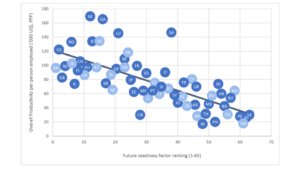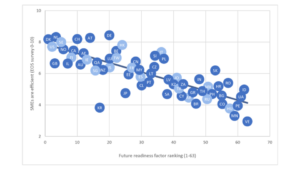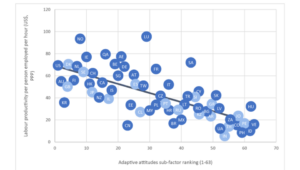
Future Readiness and Productivity relationship in the IMD World Digital Competitiveness Ranking
The second edition of the IMD World Digital Competitiveness Ranking (WDCR) was published on June 19th. This WDCR assesses the capacity of 63 economies to adapt and explore digital technologies that advance transformations in government practices, business models and society in general. Compared to 2017, the majority of countries in the study experience a relative improvement in their level of digital competitiveness while 40% of the sample shows a decline and only eight economies remain in the same position.
The WDCR is calculated by a country’s performance in three factors: knowledge, technology and future-readiness. The latter captures an economy’s level of preparedness to address effectively the digital transformation.
Research that has taken place elsewhere at IMD stresses the importance of future readiness and its components for countries and firms alike. For instance, the IMD Digital Business Transformation suggests that one of the most important component of a business’ success is the level of agility that it exhibits.
In this edition of the Criterion of the Month we will explore what is the correlation between the Future Readiness factor and indicators of productivity.
Figure 1 presents the relationship between the overall productivity per person employed by an economy on the vertical axis and the future readiness factor ranking on the horizontal. Note that the lower the number in the horizontal axis, the higher the ranking with respect to future readiness is. Thus, the strong negative correlation equal to -0.72 suggests that countries that exhibit high levels of preparedness and awareness for future digital transformation are also countries that are characterized by high levels of overall productivity.

Figure 1. Overall productivity and Future readiness
Interestingly, a similar strong relationship is demonstrated when we study the responses of mid- and upper-level managers as to how efficient the Small and Medium Enterprises are in their economy. Figure 2 captures this relationship exhibiting a correlation coefficient equal to -0.80.

Figure 2. SMEs efficiency and Future readiness
The high correlation implies that highly ranked economies, by recognizing and confronting the implied disruptions of digital technologies, are also the ones that are characterized by efficient SMEs in the eyes of the executives of a country.
Finally, it is worth examining the above relationship at the employee level. Figure 3 provides the association between the labor productivity per person employed per hour and the adaptive attitudes sub-factor. The latter identifies the ability of individuals in an economy to accommodate new technologies.

Figure 3. Labor productivity and Adaptive attitudes
Figure 3 projects a strong correlation equal to -0.70. Countries where individuals are adaptable and flexible in incorporating new technologies in their daily life, are also the countries that exhibit high levels of labor productivity.
Researchers suggest that we are in the beginning of a transformative cycle in many aspects of our economic and social lives. Even though many of these elements are yet to be determined, economies that are characterized by firms and people that are flexible and adaptable, and therefore exhibit higher levels of agility, are the ones that are more productive.
Research Information & Knowledge Hub for additional information on IMD publications

Many new businesses have emerged in recent years with few employees, no roots in the community, and heavily reliant on Big Tech for survival.
The GreenGro (A) case explores the challenges faced by GreenGro, a mid-sized agricultural technology company, as it navigates a rapidly changing industry landscape. CEO Sarah Chen and her leadership team are confronting issues ranging from technol...
The GreenGro (B) case study is a follow-up to GreenGro (A) and details how the company applied the TSUNAMI and SURF frameworks to address its complex challenges. The case illustrates the practical implementation of these frameworks, introduced in ...

With fact-checking out and community-driven moderation in, Meta is betting big on free speech – but critics warn the move could open the floodgates for disinformation and online harm.
In June 2024, at the CocoaCrafters Operating Centre, Elena Fever faced a crucial meeting with the board of directors. The discussion surrounded how to integrate Generative AI (GenAI) into the company’s supply chain strategy to enhance forecasting ...
When the dotcom bubble burst in March 2000, this did not stop the world from going digital, but it did poke holes in the concept of trust, especially in the digital world. David Goldenberg, a Belgian entrepreneur with extensive experience in manag...

The increasing pace of disruption and change means leaders need to cultivate behaviors that support their sustained success. From building strategic flexibility to broadening stakeholder connections, here is our expert guide to leading in an age o...

Global market shifts and turbulence in 2025 mean Chief Financial Officers must take into account inflation, trade tensions and shifting regulations to ensure long-term growth
China has set a bold objective to become the global leader in AI by 2030. By 2030, AI could potentially add $600 billion to China's economy annually. The country hosted over 4,500 AI companies in 2024, representing 15% of the global total. China i...

Asia's economic landscape 2024 and 2025. Three distinct approaches: Japan's technology-driven revival amid demographic challenges, China's deflation and growth concerns, and India's manufacturing ambitions through foreign investment and strategic ...
in I by IMD
Research Information & Knowledge Hub for additional information on IMD publications
Research Information & Knowledge Hub for additional information on IMD publications
The GreenGro (B) case study is a follow-up to GreenGro (A) and details how the company applied the TSUNAMI and SURF frameworks to address its complex challenges. The case illustrates the practical implementation of these frameworks, introduced in ...
Research Information & Knowledge Hub for additional information on IMD publications
The GreenGro (A) case explores the challenges faced by GreenGro, a mid-sized agricultural technology company, as it navigates a rapidly changing industry landscape. CEO Sarah Chen and her leadership team are confronting issues ranging from technol...
Research Information & Knowledge Hub for additional information on IMD publications
Case reference: IMD-7-2593 ©2024
Research Information & Knowledge Hub for additional information on IMD publications
Case reference: IMD-7-2611 ©2024
Research Information & Knowledge Hub for additional information on IMD publications
in I by IMD 8 January 2025
Research Information & Knowledge Hub for additional information on IMD publications
Research Information & Knowledge Hub for additional information on IMD publications
Research Information & Knowledge Hub for additional information on IMD publications
in I by IMD
Research Information & Knowledge Hub for additional information on IMD publications

